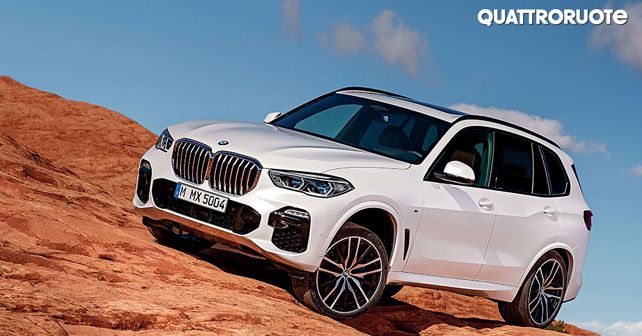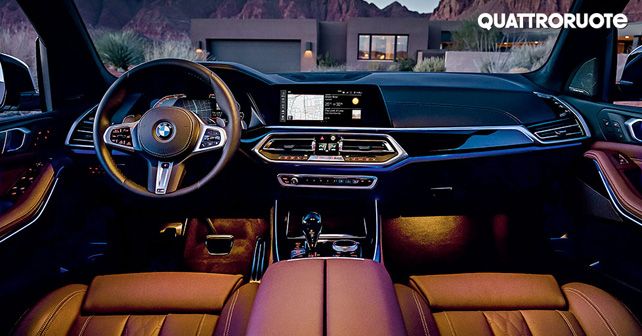
At Munich, it’s the year of SUVs – a year that began with the launch of the unprecedented X2, followed by the arrival of the all-new X4, and now it’s the time for the fourth-generation X5 that started it all for the brand twenty years ago.
To be honest, the BMW X5 wasn’t really the first of its kind in the segment – another model had already broken the ice a couple of years before it came along. In 1997, when the automotive industry dogmatically believed that off-road vehicles formed only a tiny niche of the market – existing in the shadow of high performing cars – the Mercedes-Benz M-Class arrived all of a sudden like a bolt from the blue. The M-Class – the first model from the German manufacturer to have come from Alabama, in the US – combined off-road skills similar to those of Jeep Grand Cherokees, Range Rovers and its own G-Class, with proper on-road dynamics. It incorporated a design that finally ended the spell of decades of monotonous colours and boxed designs. A path was laid down, and a segment had been created.
However, even though BMW was not the first to arrive at the scene, it did manage to transform it in a significant way. With its first-generation – the E53 of 1999 – BMW pushed the boundaries set by its rival from Stuttgart further by providing more sporty driving dynamics. This contribution of BMW to the segment is in many ways the essence of its SUVs – which are called SAVs (Sport Activity Vehicles) in Munich.
Continuity is the motto
Almost twenty years after this historic moment for BMW, the basic ideas of the project – the first of many to bear X in its name – remains the same. The fourth-generation of the X5 tenaciously clings to its formula, while evolving in terms of dimensions – it’s 30mm longer (4.92 metres) than its predecessor and 60mm wider. It even gained 40mm in its wheelbase. This dimensional evolution is effectively complemented by a moderate aesthetic reinterpretation of the double kidney radiator grille, now combined as a single element. Plus, in profile, it now seems more muscular – with the upper character line rising above the rear fender, making the tail visually more discernible.
The BMW X5, when launched, will be offered in four different trims internationally – xDrive40i, xDrive50i, xDrive30d and M50d, three of which will be offered in the European market. The xDrive50i will be equipped with a 4.4-litre, eight-cylinder turbo petrol engine, good for 462bhp and 650Nm. Of course, a pair of in-line six motors remain – the xDrive40i features a 3.0-litre turbocharged petrol engine generating 340bhp and 450Nm, the xDrive30d has a 3.0-litre turbo diesel good for 265bhp and 620Nm, while the M50d comes with a new 3.0-litre turbo diesel generating 400bhp and 760Nm. All the engines feature a standard 8-speed automatic transmission.
Ready to go off-road
To send its power to the ground more effectively, the all-wheel drivetrain has been significantly improved. It offers a setup that favours the torque transmission to the rear axle and a more refined rear electronic differential. The standard suspension setup also includes a Dynamic Damper Control system that electronically manages the damper settings on the fly. Customers can also opt for the Adaptive M Pro suspension, along with the Integral Active Steering and air suspension at all four corners – introduced for the first time on the X5 – with a height adjustment range of up to 80mm. For a model known for its driving accuracy on asphalt, the most interesting and innovating feature in the new X5 will be its ‘off-road package,’ which offers four different driving modes for four different surfaces – sand, rock, gravel and snow. No matter what, the new X5 should be able to tackle it all. But that doesn’t mean that the X5 has ignored the asphalt, for there are some interesting upgrades in terms of driver assistance. These include adaptive cruise control with a stop & go function, lane-keeping assist, an automatic lane-change function, cross-traffic alert and traffic jam assist, amongst others – all of which renders the X5 with level 2+ autonomy in terms of driving assistance.
The X5 now also comes with a self-parking function and Emergency Stop Assistance, which is activated in case of an emergency and can safely bring the car to a halt. Back-up assistant is another feature that deserves mention, as it has the ability to retrace the exact path of the car – in reverse gear of course – for up to 50 metres. The new X5, which is to scheduled to be launched in November, will be manufactured in Spartanburg, South Carolina (USA).
The X5 has grown, and this allows for increased space in the third row of the seven-seater version. The capacity of the boot, in different configurations, ranges between 645 to 1,860-litres.
BMW’s new operating system represents an important innovation for the user interface, which moves toward the reduction of all distractive elements. The X5 gets a digital instrument cluster and a central screen – both measuring 12.3 inches.
The fourth-gen X5 carries on the new stylistic dialogue of the double kidney grille unified in a single chrome frame – a solution with few precedents in the history of the brand. Below: the interior appears more traditional.
© Riproduzione riservata





























Write your Comment